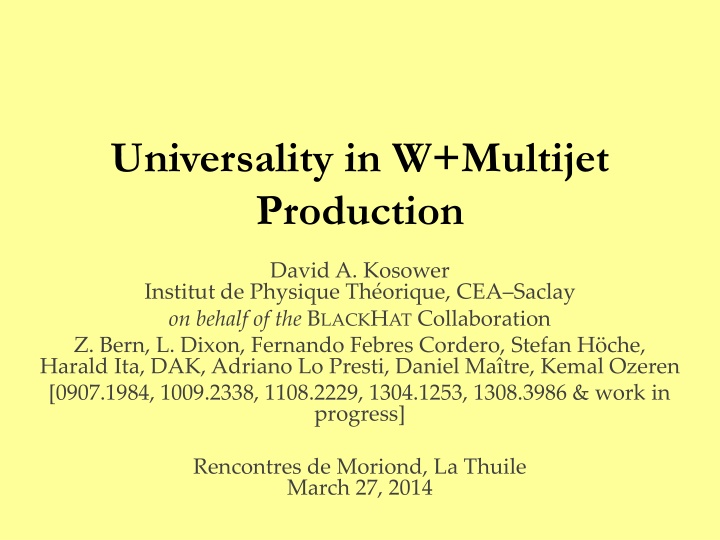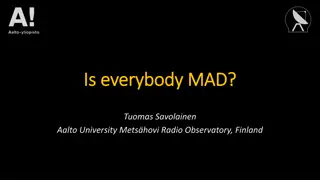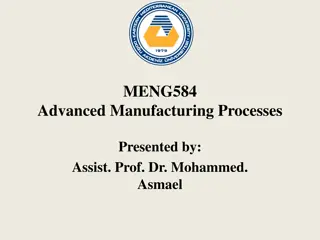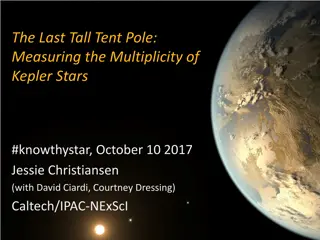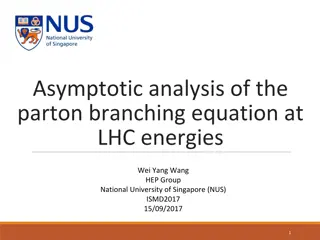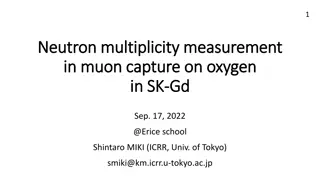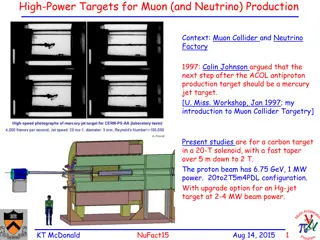Challenges and Solutions in High-Multiplicity Jet Production Studies
Theory and methodology challenges in the universality and production of W+multijet events are discussed, emphasizing the importance of accurate predictions and scale independence. The NLO revolution and on-shell methods are explored, along with software tools like BLACKHAT and SHERPA. Managing computations at high multiplicity is complex, but solutions like n-tuples provide a way to efficiently recycle matrix elements and configuration data, facilitating analysis and collaboration.
Download Presentation

Please find below an Image/Link to download the presentation.
The content on the website is provided AS IS for your information and personal use only. It may not be sold, licensed, or shared on other websites without obtaining consent from the author.If you encounter any issues during the download, it is possible that the publisher has removed the file from their server.
You are allowed to download the files provided on this website for personal or commercial use, subject to the condition that they are used lawfully. All files are the property of their respective owners.
The content on the website is provided AS IS for your information and personal use only. It may not be sold, licensed, or shared on other websites without obtaining consent from the author.
E N D
Presentation Transcript
Universality in W+Multijet Production David A. Kosower Institut de Physique Th orique, CEA Saclay on behalf of the BLACKHAT Collaboration Z. Bern, L. Dixon, Fernando Febres Cordero, Stefan H che, Harald Ita, DAK, Adriano Lo Presti, Daniel Ma tre, Kemal Ozeren [0907.1984, 1009.2338, 1108.2229, 1304.1253, 1308.3986 & work in progress] Rencontres de Moriond, La Thuile March 27, 2014
Theory for Many Jets Want quantitative predictions Renormalization scale needed to define ??; factorization scale to separate long-distance physics Physical observables should be independent of scales; truncated perturbation theory isn t LO has large dependence NLO reduces this dependence NLO importance grows with increasing number of jets Expect predictions reliable to 10 15% <5% predictions will require NNLO
NLO Revolution: On-Shell Methods Formalism Known integral basis: On-shell Recursion; D-dimensional unitarity via mass Unitarity in D = 4
BLACKHAT + SHERPA BLACKHAT One-loop matrix elements Software library and its eponymous collaboration Automated, numerical implementation of unitarity method COMIX Born + real-emission matrix elements Catani Seymour subtraction terms SHERPA Process Management Phase-space integration No showering
Running at High Multiplicity Managing a high-multiplicity computation is complicated Many different contributions with wide dynamic range Split up into parts of different significance to compute with different statistics Many pieces to baby-sit & combine Computationally intensive Would need to repeat for each scale choice; each PDF within an error set; each new observable Computing matrix elements overwhelmingly dominates computation time at given scale Computing new observables is cheap Varying R, F also cheap once terms within matrix element are known Likewise for choice of parton distributions
n-Tuples Solution: recycle! Compute matrix elements once, save phase-space configurations with weights & coefficients needed to recompute for different R, F, PDFs Save these as ROOT n-tuple files Analyses done with lightweight C++ or ROOT codes Bonus: distribute these to experimenters, who can do their own analyses Only real restriction is to preselected set of jet algorithms Jet, lepton/photon pT, rapidity cuts can be tightened PDFs, scales can be chosen differently Now available publicly for W,Z+ 4 jets, QCD 4 jets, +2 jets (std & VBF)
W+4 Jets Scale variation reduced substantially at NLO; central scale ?T Successive jet distributions fall more steeply Shapes of 4th jet distribution unchanged at NLO but first three are slightly steeper /2
W+5 Jets Scale-uncertainty bands shrink dramatically Last jet shape is stable, harder jets have steeper spectrum at NLO Last three jet shapes look similar, just getting steeper
Jet-Production Ratios Ratios reduce uncertainties both in experiment and theory W+1: missing subprocesses W+2: kinematic restrictions (W cannot be close to leading jet) Looking differentially: relaxation of kinematic restrictions leads to substantial NLO corrections at large pT in W+3/W+2, corrections smaller for higher multiplicity Ratio is not constant as a function of jet or WpT Studies suggest similarities of shapes of ratios
Extrapolations Let s try extrapolating ratios to larger n We know the W+2/W+1 ratio behaves differently from W+n/W+(n 1) ratios, because of kinematic constraints & missing processes (especially at LO) We could extrapolate from W+4/W+3 & W+3/W+2 but with two points and two parameters, how meaningful is that? With the W+5/W+4 ratio, a linear fit (with excellent 2/dof) makes the extrapolation meaningful: W + 6 jets: 0.15 0.01 pb W++ 6 jets: 0.30 0.03 pb Uncertainty estimates from Monte-Carlo simulation of synthetic data
jet Distribution ?T Look at distribution of total transverse energy in jets: good probe into high-pT physics Different peaks Different thresholds Let s try to extrapolate the distribution to W+6 jets
Cant extrapolate point-by-point: different thresholds, different peaks, different phase space Try fitting & extrapolating fit parameters What form should we use? At small HT, integral looks like where ? = [?T/ ? ?Tmin]2 At large HT, phase space becomes constrained, suggesting a factor like 1 ?T/?T ???/??T max ? (previously seen in ?) Try Terrible fit
Extrapolating But for ratios of distributions, this form gives great fits! Extrapolate ?,?: linear extrapolations work well; fit N to total cross section Use numerics or fit form (more convenient) for ???+2/??T
Summary Study of an important Standard-Model process at high jet multiplicity: W+4,5 jets Study of Standard-Model signals in widely-varying kinematic regimes gives confidence in our ability to understand backgrounds quantitatively at high multiplicity Reliability of ratios, signs of universality for 3 jets Extrapolations to W+6 jets
